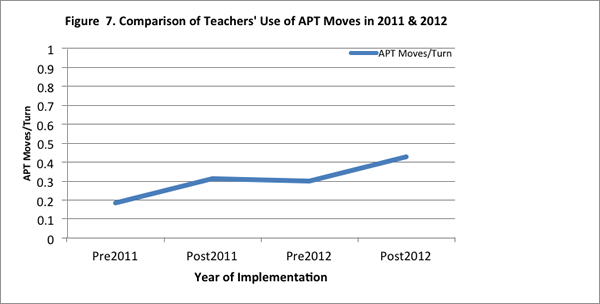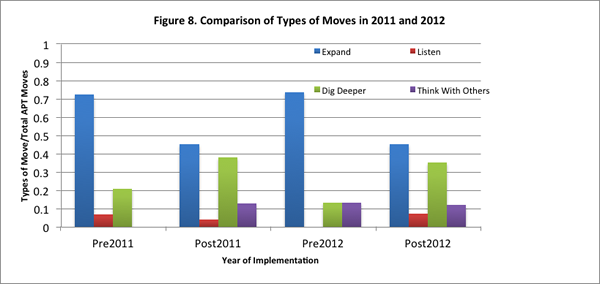Grade 4 Science Discussions 2011-2012
Comparative Analysis of Findings from 2010-2011 & 2011-2012
It should be noted that the concept cartoons used for pre- and post-discussions in 2011-2012 were different from those used in 2010-2011. Furthermore, the coding rubric for students’ talk underwent some changes between the two years. These differences notwithstanding, certain comparisons were drawn for four teachers — Evans, Smith, Hein, and Wolf — who participated two times in the Talk Science program, and have pre and post discussion data for both years. The comparative analysis between 2010-2011 and 2011-2012 revealed the following patterns:
During both years, teachers used more talk moves in the post-discussions than the pre-discussions (see Figure 7). The APT moves accounted for 18.47% of teachers’ turns in pre-discussions in 2011; 31.56% in post-discussions in 2011; 30.16% in pre-discussions in 2012; and 42.93% in post-discussions in 2012.

We analyzed further the four teachers’ use of the various APT Moves (4 categories of moves: Expand; Listen; Dig Deeper; Think with Others). See Figure 8. Figure 8 shows that when considering the total number of APT moves used by the four teachers, in 2011, the teachers (when examined together) predominantly used the Expand moves in the pre-discussions (72.41% of all the APT moves in pre2011). There was less use of Dig Deeper moves, an even lesser use of the Listen moves (6.9%), and no use of the Think with Others moves in the pre-discussions in 2011. In post 2011 discussions, whereas the teachers continued to show a fair amount of use of the Expand moves (45.07%), they showed a marked increase in their use of the Dig Deeper moves (about 38%). They also incorporated the Think with Others moves in the post-discussions in 2011 (12.68%). These are positive findings indicating that teachers were able to draw on these two sets of moves through participation in the Talk Science program. But they continued to make less use of the Listen moves in the post-discussions in 2011 (4.23%).
In 2012, similar to their facilitation in the previous year, the four teachers (when examined together) continued to use the Expand moves in the pre- and post- discussions to a large extent (73.68% in pre2012; 45.12% in post 2012). Similar to 2011, the four teachers started their facilitation in 2012 with less use of the Dig Deeper moves (13.16% of their APT moves in pre 2012), but showed marked increase in the use of this type of moves in the post-discussions (35.37%).
With respect to the use of Think with Others moves, we found that in 2012, teachers started by making some use of this set of moves they had learnt through the Talk Science program from the previous year (13.16% of the APT moves in pre 2012 discussions). This is an encouraging finding because in pre 2011 discussions, teachers had not made any use of these moves. Their initial use of these moves in 2012 was almost as much as where they had ended in 2011 (13.16% in pre 2012; 12.68% in post 2011), suggesting that teachers had retained this set of moves in their practice. However, there was not much increase in the use of these moves in post 2012.
Finally, with respect to the use of Listen moves, we found that similar to their facilitation in 2011, the four teachers (when examined together) continued to make less use of the Listen moves in 2012. They did not use any Listen moves in pre 2012 discussions, but made some use of this move in the post 2012 discussions (7.32% of the APT moves).
Overall, the comparative analysis indicated that teachers were able to incorporate various talk moves into their practice, particularly the Dig Deeper moves, for guiding science discussions. Furthermore, although they made some use of the Think with Others and Listen moves, in general, teachers tended to focus less on these two sets of talk moves.




